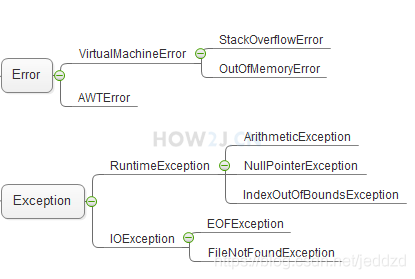Java 中异常的分类
异常分类: 可查异常,运行时异常和错误3种
其中,运行时异常和错误又叫非可查异常
步骤 1 : 可查异常
可查异常: CheckedException
可查异常即必须进行处理的异常,要么try catch住,要么往外抛,谁调用,谁处理,比如 FileNotFoundException
如果不处理,编译器,就不让你通过
package exception;
import java.io.File;
import java.io.FileInputStream;
import java.io.FileNotFoundException;
public class TestException {
public static void main(String[] args) {
File f= new File("d:/LOL.exe");
try{
System.out.println("试图打开 d:/LOL.exe");
new FileInputStream(f);
System.out.println("成功打开");
}
catch(FileNotFoundException e){
System.out.println("d:/LOL.exe不存在");
e.printStackTrace();
}
}
}
步骤 2 : 运行时异常
运行时异常RuntimeException指: 不是必须进行try catch的异常
常见运行时异常:
除数不能为0异常:ArithmeticException
下标越界异常:ArrayIndexOutOfBoundsException
空指针异常:NullPointerException
在编写代码的时候,依然可以使用try catch throws进行处理,与可查异常不同之处在于,即便不进行try catch,也不会有编译错误
Java之所以会设计运行时异常的原因之一,是因为下标越界,空指针这些运行时异常太过于普遍,如果都需要进行捕捉,代码的可读性就会变得很糟糕。
package exception;
public class TestException {
public static void main(String[] args) {
//任何除数不能为0:ArithmeticException
int k = 5/0;
//下标越界异常:ArrayIndexOutOfBoundsException
int j[] = new int[5];
j[10] = 10;
//空指针异常:NullPointerException
String str = null;
str.length();
}
}
步骤 3 : 错误
错误Error,指的是系统级别的异常,通常是内存用光了
在默认设置下,一般java程序启动的时候,最大可以使用16m的内存
如例不停的给StringBuffer追加字符,很快就把内存使用光了。抛出OutOfMemoryError
与运行时异常一样,错误也是不要求强制捕捉的
package exception;
public class TestException {
public static void main(String[] args) {
StringBuffer sb =new StringBuffer();
for (int i = 0; i < Integer.MAX_VALUE; i++) {
sb.append('a');
}
}
}
步骤 4 : 三种分类
总体上异常分三类:
错误
运行时异常
可查异常

运行时异常 RuntimeException,能否被捕捉?
错误Error,能否被捕捉?
面试题常问题: 运行时异常与非运行时异常的区别
答案:
都可以.
package exception;
public class TestException {
public static void main(String[] args) {
String str = null;
try {
str.toString();
} catch (NullPointerException e) {
System.out.println("捕捉到运行时异常: NullPointerException ");
}
StringBuffer sb = new StringBuffer("1234567890");
try {
for (int i = 0; i < 100; i++) {
sb.append(sb.toString());
}
} catch (OutOfMemoryError e) {
System.out.println("捕捉到内存用光错误: OutOfMemoryError");
}
}
}
运行时异常与非运行时异常的区别:
运行时异常是不可查异常,不需要进行显式的捕捉
非运行时异常是可查异常,必须进行显式的捕捉,或者抛出




















 1701
1701











 被折叠的 条评论
为什么被折叠?
被折叠的 条评论
为什么被折叠?








